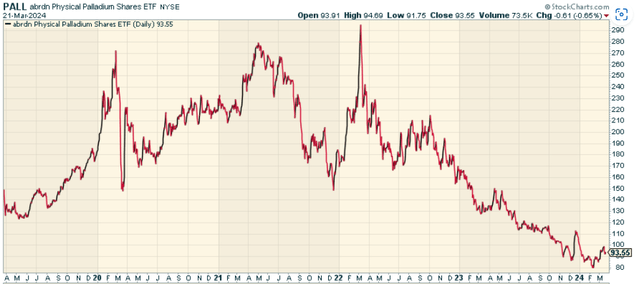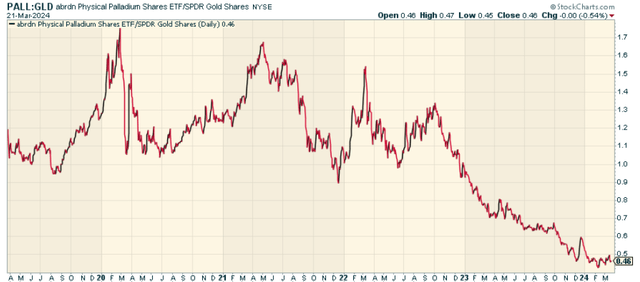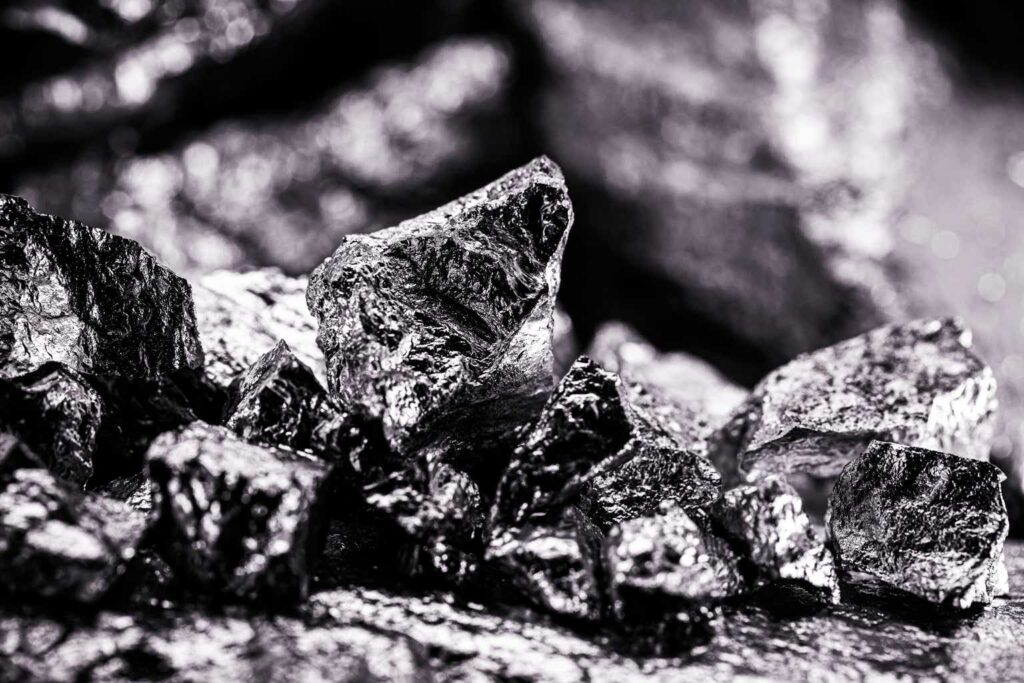I’ve recently been writing about precious metals more broadly here on Seeking Alpha, and think it’s worth getting a bit more granular on specific commodities like Palladium. As a critical component in automotive catalytic converters, palladium benefits from stringent emission regulations driving demand, especially with the shift towards petrol engines where it’s more effective than platinum. Additionally, its rarity, coupled with supply constraints primarily from Russia and South Africa, creates potential for price appreciation amidst geopolitical tensions and mining challenges. With technological advancements, such as fuel cells for clean energy, the demand for palladium may surge, offering a hedge against inflation and currency devaluations.
To that end, the abrdn Physical Palladium Shares ETF (NYSEARCA:PALL) is a great ETF to gain exposure to Palladium as part of your commodity portfolio allocations should you have one. PALL is an exchange-traded fund that seeks to reflect the performance of the price of physical palladium, less the Trust’s expenses. The fund provides investors with a cost-effective and convenient way to invest in palladium, at just 0.60%.
The ETF is backed by physical palladium held in vaults in London, UK, and Zurich, Switzerland. PALL’s holdings are entirely dedicated to physical palladium bullion. As such, the fund’s value is directly related to the price of palladium. This setup gives investors direct exposure to the price movements of palladium, making PALL a potentially attractive investment for those seeking exposure to this specific commodity.
Here’s where Palladium gets particularly interesting. China’s economic growth is pivotal to the global demand for palladium, largely due to its status as the world’s largest consumer of the metal, driven by its vast automotive industry that relies heavily on palladium for the manufacturing of catalytic converters. With China implementing more stringent vehicle emissions policies, such as the CHINA 6 standards, the need for palladium has intensified, evidenced by a tenfold increase in demand from 2001 to 2020. However, China’s limited domestic palladium reserves necessitate substantial imports, accounting for nearly 89% of its palladium supply, predominantly from geopolitical hotspots like Russia, highlighting both the importance of China’s economic trajectory for palladium markets and the potential vulnerabilities to supply disruptions.
China has been a terrible performer on the economic stage, but should China recover and re-accelerate, it would likely pull Palladium with it. This means that there could be a new multi-year cycle favoring Palladium based on China’s own economic cycle improving. Weakness alone can be attributed to China when we look at how poorly Palladium has performed over the last several years.
stockcharts.com
Peer Comparison
Comparing PALL to other similar ETFs can offer valuable insights. Other ETFs in the precious metals sector include the SPDR Gold Shares (GLD) and the iShares Silver Trust (SLV). However, these funds track the prices of gold and silver, respectively, making them fundamentally different from PALL. The primary distinguishing factor for PALL is its focus on palladium, a metal that has seen increasing demand over the years. This unique focus could make PALL an attractive investment for those seeking exposure to palladium’s price movements.
PALL relative to GLD is still in a downtrend, but may be bottoming, suggesting that it could actually start outperforming Gold fairly soon.
stockcharts.com
Pros and Cons of Investing in PALL
Like any investment, PALL comes with its own set of advantages and drawbacks.
Pros
-
Exposure to Palladium: PALL offers direct exposure to the price of palladium, a precious metal with increasing demand due to its use in various industrial applications.
-
Hedge Against Inflation: Like other precious metals, palladium can act as a hedge against inflation. As such, PALL could potentially offer protection in times of economic instability.
-
Physically Backed: PALL is backed by physical palladium, which provides a degree of security for investors.
Cons
-
Dependence on Industries: Palladium’s price is heavily dependent on its industrial applications, particularly in the automotive sector. Any significant changes in these industries could impact PALL.
-
Geopolitical Risks: A significant portion of the world’s palladium supply comes from Russia and South Africa. Any geopolitical issues in these regions could disrupt palladium supply, impacting PALL.
-
No Dividends: As a commodity-based ETF, PALL does not pay dividends. This could be a disadvantage for income-focused investors.
Conclusion: To Invest or Not to Invest?
In conclusion, investing in the abrdn Physical Palladium Shares ETF presents a unique opportunity to gain exposure to the price movements of palladium. I think it can start playing catch-up to Gold here, and any green shoots from China likely provides upward momentum.
Read the full article here



